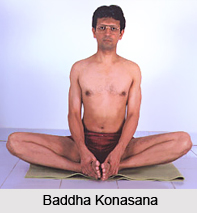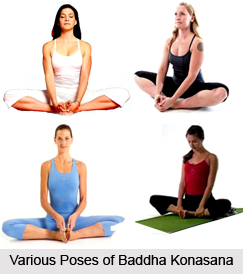 Baddha Konasana is a cultural asana effective in strengthening the hips and groin. The contemporary Baddha Konasana is near identical to the classical Bhadrasana, a meditative posture with a very long history in Yoga practice.
Baddha Konasana is a cultural asana effective in strengthening the hips and groin. The contemporary Baddha Konasana is near identical to the classical Bhadrasana, a meditative posture with a very long history in Yoga practice.
Meaning of Baddha Konasana
Baddha means bound, while kona means angle. Bound Angle Pose, also called Cobbler`s Pose after the typical sitting position of Indian cobblers. Traditional texts say that Baddha Konasana destroys disease and gets rid of fatigue. It is therapeutic for flat feet, high blood pressure, infertility, and asthma.
Yoga Texts and Baddha Konasana
Textual sources indicate that Baddha Konasana is arguably the contemporary name for Bhadrasana, a major meditative asana in the Yoga tradition.
Bhadrasana enjoys a high position in several of the classic yoga texts. It is listed as one of the first four most important asanas amongst the 84 Classic Yoga asanas of Shiva in the Hatha Yoga Pradipika (1400 AD) and is also included in the list of 84 asanas compiled in the Hatha Ratnavali, where it is not included in the first four. It is also described in the Shri Tattva Nidhi, a later text. Consequently, it is evident that what is known today as the Baddha Konasana has been in yoga practice for a considerable period of time, and has also been given pride of place in several major asana compendia.
Practice of Baddha Konasana
* Sit with your legs straight out in front, with raised pelvis on a blanket if the hips or groins are tight.
* Bend the knees with exhalation. Pull the heels toward the pelvis, then drop the knees out to the sides and press the soles of the feet together.
* Bring the heels as close to the pelvis as is comfortably possible.
* Grasp the big toe of each foot with the first and second finger and thumb. Always keep the outer edges of the feet firmly on the floor. If it isn`t possible to hold the toes, clasp each hand around the same-side ankle or shin.
 * Sit so that the pubis in front and the tailbone in back are equidistant from the floor. The perineum then will be approximately parallel to the floor and the pelvis in a neutral position.
* Sit so that the pubis in front and the tailbone in back are equidistant from the floor. The perineum then will be approximately parallel to the floor and the pelvis in a neutral position.
* Firm the sacrum and shoulder blades against the back and lengthen the front torso through the top of the sternum.
* Do not ever force the knees down. Instead release the heads of the thighbones toward the floor. The knees will follow the action.
* Stay in this pose anywhere from 1 to 5 minutes. Then inhale, lift the knees away from the floor, and extend the legs back to their original position.
To understand the release of the heads of the thigh bones, fold two blankets and put one under each outer thigh, supporting the thighs an inch or so above their maximum stretch. Then lay a 10-pound sand bag on each inner groin, parallel to the crease between the thigh and pelvis. Release the thigh heads away from the weight, and let them sink into the blankets. Do not use the bags unless the thighs are supported.
Effects of Baddha Konasana
* This asana stimulates abdominal organs, ovaries and prostate gland, bladder, and kidneys.
* Stimulates the heart and improves general circulation
* Stretches the inner thighs, groins, and knees.
* Helps relieve mild depression, anxiety, and fatigue.
* Soothes menstrual discomfort and sciatica
* Helps relieve the symptoms of menopause
* Consistent practice of this pose until late into pregnancy is said to help ease childbirth.
Precautions
The asana should be avoided in case of Groin or knee injury.




















